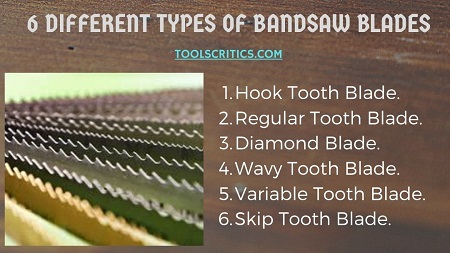
If you are a woodworker, whether a professional or a DIY artist, you probably use a band saw in your day-to-day projects. And while you might be well-versed with the bandsaw, how well do you know about their blades?
By the way, did you know that bandsaw blades are categorized based on the type of teeth? There are different types of bandsaw blades, which define their functions and purpose when handling a specific project.
Table of Contents
Different Types of Bandsaw Blades
That being said, let’s look at the common band saw blade types, shall we?
1. Hook Tooth Blade.
This blade comes with teeth that look like hooks. It has a positive wide rake angle, along with a 10-degrees undercut face. These blades allow you to make deep cuts on almost any size of the wood piece. Normally, hook-tooth blades are designed for high-speed and coarse cuts. In other words, they can easily work perfectly for you if you have a high-demanding project to work on with your bandsaw.
Also, it would be the perfect blade to cut non-ferrous metal or hardwood workpieces. Furthermore, the blade can easily handle cast iron.
But one major drawback of the hook-tooth blade is that it is short in length. Plus, they are not always the best pick for delivering accurate finishing on your projects.
2. Regular Tooth Blade.
This is the most common blade that you have on your bandsaw. You will also find it whenever you purchase a bandsaw. Since it comes with regular teeth, this type of blade is used for general metal cutting. But it can also be used for woodworking projects as it delivers some smooth finishing as well. These blades normally come with straight-faced teeth, and they have deep gullets between every tooth.
Some people call it standard saw blades, and it is well known to make accurate cuts on softwood and hardwood.
3. Diamond Blade.
As you would guess, a diamond blade is mostly used for tough workpieces, like metal works. But it can also work on some woodworking projects. However, a diamond blade is specifically meant for metal works.
The diamond blade can cut all the hard materials. Some of the common types of materials that a diamond blade can cut include concrete, tiles, brick, reinforced concrete, marbles, glass, ceramic, as well as porcelain.
They have super sharp and strong teeth that can eat through just about any material you throw at them.
4. Wavy Tooth Blade.
With wavy-tooth blades, they allow the bandsaw to run comfortably while cutting multiple shapes on workpieces. The blade comes with wavy teeth that allow getting rid of tooth stripping as you saw thin sections of sheet stock, pipe, tubing, among other materials.
5. Variable Tooth Blade.
Also known as broach-tooth blades, the variable tooth blade is the most different of all the bandsaw blade types.
They are then split into two categories;
Variable pitch blade and variable tooth blade
With the variable tooth blade, it is mostly used to minimize the vibrations of the bandsaw. Thanks to the depth gullet and the multiple angles of the teeth, the blade will run smoothly, which then reduces the vibrations.
The variable pitch blade, on the other hand, is different not with the teeth angles, rather the size. Here, the size of the teeth will be calculated in TPI.
Variable tooth blades happen to be the ultimate woodworking band saw blade types. It tends to reduce the vibrations, which then allows you to make cleaner or angled cuts with your bandsaw. If you have any woodworking project and you need perfect results with your finishes, the variable pitch blade is the best pick for you.
6. Skip Tooth Blade.
The last type of bandsaw blade on the list is the skip-tooth blade. This blade comes with a flat gullet and a zero rake angle, and it has an almost similar design to the hook tooth blade. This blade comes with a 90-degree tooth, and with sharp angles, which is where the gullets meet. The skip tooth blade works best in making soft cuts or woodworking projects.
Besides wood pieces, these blades are also used to cut metal pieces. But it is not the perfect pick for making clean finishes. However, the blade does an amazing job if you need to make long workpieces. Just keep in mind that they don’t make such a smooth finish.
FAQs
Q. Does Size Matter in the Type of Bandsaw Blade?
Ans. Yes, the size of the blade will depend on what project results in it gives you. The right size of blade will always get the work done. If the size isn’t right, it will give you bad performance. The blade should perfectly fit in your bandsaw for the saw to run smoothly. Furthermore, make sure that you maintain proper lubrication with the right lubricant and not water.
Final Words
So, these are the different types of bandsaw blades that are available to use for your project. Above all, ensure that you use the bandsaw with care while observing all the safety precautions.